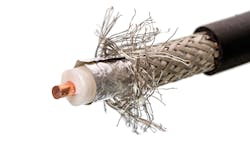Carlisle Interconnects Buys Cable Maker Micro-Coax
Carlisle recently acquired Micro-Coax, one of the biggest makers of coaxial cable for transmitting high-frequency radio signals. The company will become part of Carlisle Interconnect Technologies, a business unit that produces wiring and connectors for microwave applications.
Both companies make shielded wire and coaxial cable, in addition to other parts like connectors and contacts. These products are primarily used to connect radio transmitters and receivers with antennas inside military electronics, satellites, automated factory systems, airplanes, test equipment, and medical devices.
The terms of the deal were not disclosed. Carlisle also acquired one of Micro-Coax’s business units, Kroll Technologies, which provides electro-plating services and fabricates metal parts for a wide range of industries.
Based in Pennsylvania, Micro-Coax has been a long-time supplier of semi-rigid coaxial cable, a special type of transmission line that severely limits the power lost when signals pour into cables. Semi-rigid cables have “the advantage of the smallest possible diameter, nearly 100% isolation, and near-theoretical textbook attenuation,” said Chris Kneizys, Micro-Coax’s chief executive, in a 2015 interview with Microwaves & RF.
While both companies make overlapping products, the scale of their operations are worlds apart. Carlisle Interconnect Technologies, which is organized under a holding company, generated revenues of $196.7 million in the first quarter of 2016, according to government filings. That represents nearly a fourth of the holding company’s total revenue for the quarter.
Last year, Micro-Coax only had annual revenues around $45 million, according to a Carlisle statement. Though small, the company was in the process of expanding before the deal. Last month, Micro-Coax began growing its staff – now standing at 235 – hiring for positions in manufacturing and engineering to help transition into new markets.
Micro-Coax was founded in 1962. A.H. Mainwaring, the engineer that invented the precursor to semi-rigid cables, established the company as a business unit of his first venture, Uniform Tubes. The firm’s first major achievement came the following year, with the design of gold jackets for the cabling inside the first Apollo spacecraft.
Over the next 50 years, the company expanded into delay lines, connectors, and products for shielding electromagnetic interference. One such shielding technology, Aracon, is a yarn-like conductive fiber that can replace metal and conventional braided cable in airplane electronics. Its natural and synthetic fibers are treated to conduct electricity and the resulting yarn is stronger, lighter, and more flexible than metal wire.
“We are excited about the acquisition of Micro-Coax, as the company adds capabilities and technology to strengthen our interconnect products business in very attractive sectors,” Chris Koch, Carlisle’s chief executive, said in a statement.
Looking for parts? Go to SourceESB.
About the Author

James Morra
Senior Editor
James Morra is the senior editor for Electronic Design, covering the semiconductor industry and new technology trends, with a focus on power electronics and power management. He also reports on the business behind electrical engineering, including the electronics supply chain. He joined Electronic Design in 2015 and is based in Chicago, Illinois.
